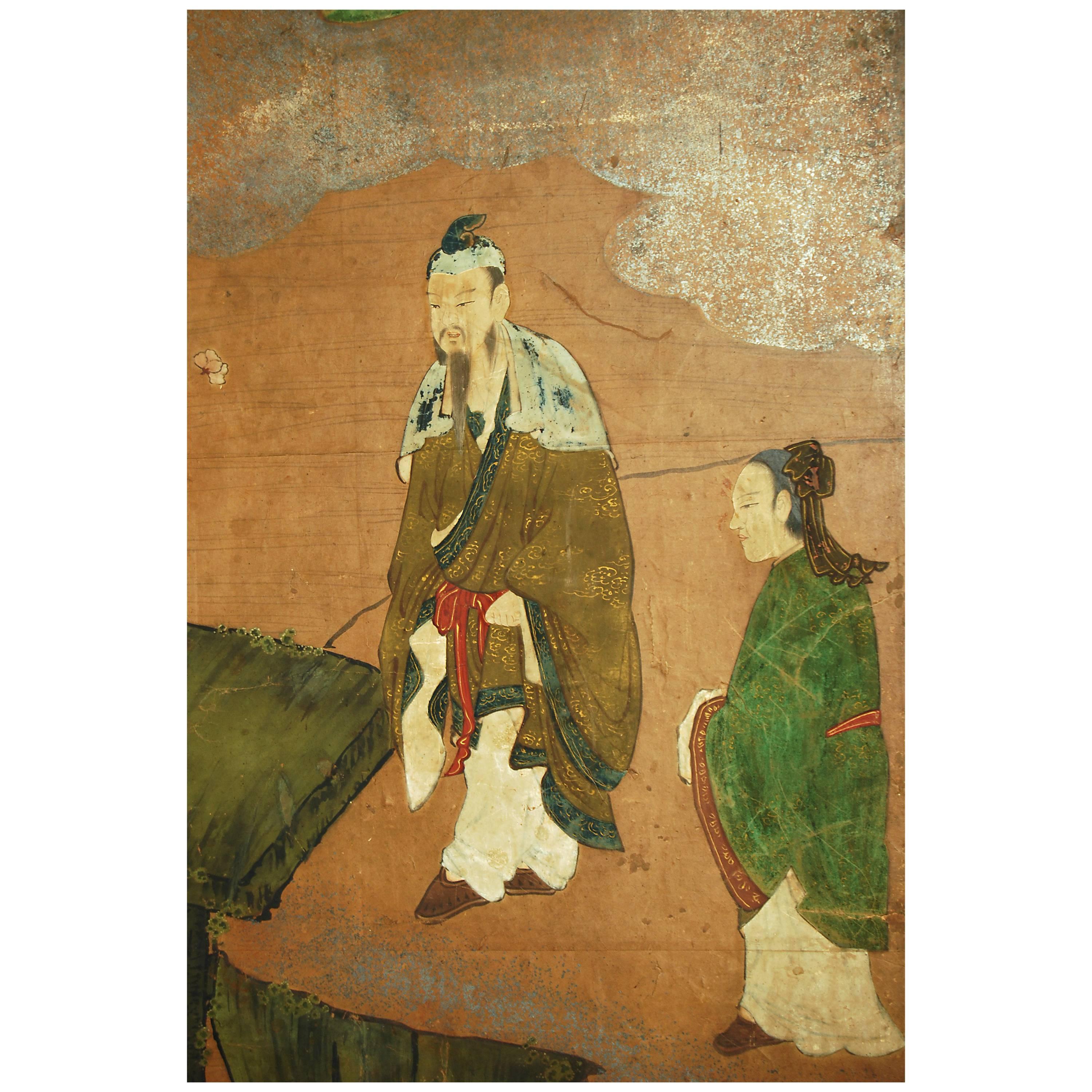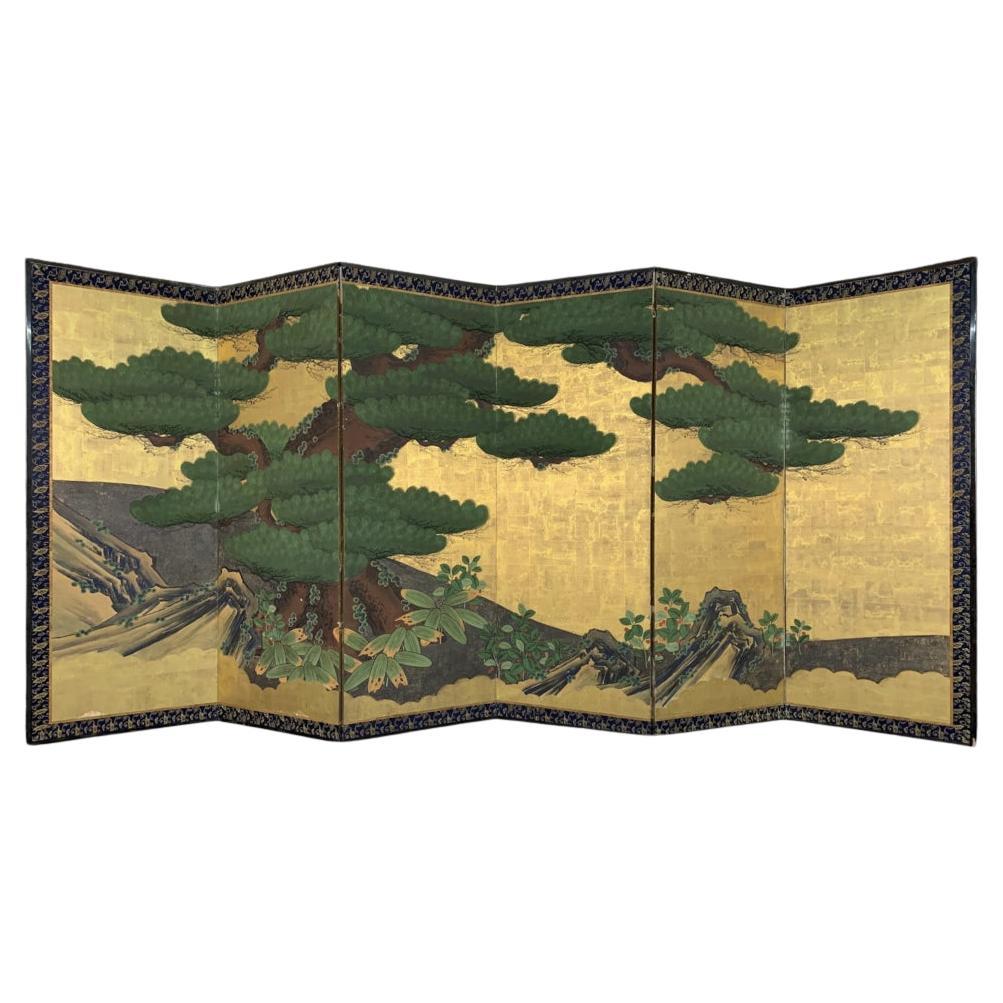Items Similar to 18th Century Japanese Screen Pair. Plum & Young Pines. Kano School.
Want more images or videos?
Request additional images or videos from the seller
1 of 7
18th Century Japanese Screen Pair. Plum & Young Pines. Kano School.
About the Item
Dimensions (Each screen): H. 176 cm x W. 378 cm (69’’ x 149’’)
This pair of Japanese folding screens depict blossoming plum trees amongst young pines. They are designed to capture the changing seasons, from winter to spring, reflecting the cyclical nature of life and seeking inspiration from it. Rather than a naturalistic depiction, here the trees and flowers are depicted in a heavily stylized manner influenced by traditional Chinese landscape painting. The copious use of gold leaf conveys a sense of opulence and grandeur and this pair of screens have a particularly beautiful patina. The composition makes full use of the large canvas without overwhelming the space. The negative space is utilized to emphasize the elegant lines and curves of the plum branches and the youthful nature of the pine trees.
These screens were painted by a member of the influential Kano academy of painters. The Kano school operated as a hereditary school with a widespread workshop system. Kano school artists were renowned for producing large-scale screen paintings. These screens were used to define and decorate spaces in castles, temples, and other significant locations. These large-scale screen paintings not only served as decorative elements but also played a role in conveying cultural and historical narratives.
This pair of screens would have been displayed around the New Year period, emphasizing the values of perseverance and strength in the pursuit of a disciplined and enlightened life. The plum blossom is one of the first flowers to bloom in late winter or early spring, signifying hope and renewal. It is widely admired for its beauty and fragrance. In art, the plum blossom represents the coming of spring after the harsh winter, making it a symbol of endurance and new beginnings. The young pine trees similarly convey feelings of revitalization and hope, whilst its evergreen nature also alludes to perpetuity and timelessness.
- Dimensions:Height: 69 in (175.26 cm)Width: 149 in (378.46 cm)Depth: 0.75 in (1.91 cm)
- Sold As:Set of 2
- Style:Edo (Of the Period)
- Materials and Techniques:
- Place of Origin:
- Period:
- Date of Manufacture:Circa 1780
- Condition:Refinished. Wear consistent with age and use. This pair of screens have recently been conserved and fully remounted. The original lacquered frames, metalwork and silk brocade have been retained. Expert Japanese craftsmen and entirely traditional techniques and materials were used.
- Seller Location:Kyoto, JP
- Reference Number:1stDibs: LU2472337540322
About the Seller
5.0
Recognized Seller
These prestigious sellers are industry leaders and represent the highest echelon for item quality and design.
Gold Seller
These expertly vetted sellers are highly rated and consistently exceed customer expectations.
Established in 2001
1stDibs seller since 2016
60 sales on 1stDibs
Typical response time: 6 hours
- ShippingRetrieving quote...Ships From: Kyoto, Japan
- Return PolicyA return for this item may be initiated within 10 days of delivery.
More From This SellerView All
- Circa 1700 Japanese Screen Pair, Cranes & Pines, Kyoto Kano SchoolLocated in Kyoto, JPPines and Cranes Anonymous. Kyoto Kano School. Late 17th/early 18th centuries, circa 1700. Pair of six-panel Japanese folding screens. Ink, gofun, pigment and gold leaf on paper. This bold composition presents two pine trees extending to the left and right across a gold leaf background. One tree is silhouetted against a green ground, golden clouds obscuring its true size, the other stretches across a stylized waterway. The pines are paired with Manchurian cranes with red crests and snow white plumage. Both have been highly auspicious motifs in East Asia since Chinese antiquity. Here the artist utilized fluid and instinctive ink brushstrokes to define the trunk, branches and tail feathers, in strong contrast to the precision and sharp angularity of the crane’s legs and beaks. The adoption of this vast metallic painting support required an unerring sense of design and composition, so that the negative space surrounding motifs could imply context for the otherwise floating pictorial elements. The brushwork detailing the trunks of the pines, the exaggerated dimensions of the pine trees and the strength and dynamism of the composition are all reminiscent of Kano Eitoku...Category
Antique Late 17th Century Japanese Edo Paintings and Screens
MaterialsGold Leaf
- 17th Century Japanese Screen. Ink Plum Tree & Birds by Kano Naonobu.Located in Kyoto, JPKano Naonobu (1607-1650) Plum Tree and Birds Six-fold Japanese Screen. Ink and slight color on paper. In this evocative ink work spread over a six-panel folding screen, we see the consummation of the elegance and refinement of the Edo Kano school. This 17th century screen is a rare surviving example of a large-scale bird and flower painting by Kano Naonobu, the younger brother of Kano Tanyu...Category
Antique 17th Century Japanese Edo Paintings and Screens
MaterialsWood, Paper
- Japanese Screen Pair, circa 1730, Peacocks and Phoenix, Kano SchoolLocated in Kyoto, JPPhoenix and Peacocks. A pair of six-panel Japanese folding screens by Tsunetake Yotei (n.d.) First half of the 18th century. The signature reads 67 year old Tsunetake. The seals read: -Tsunetake no in, -Yotei, -Seishin Dimensions: Each screen – H. 69” x W. 149” (176 cm x 378 cm) A pair of Kano Grand Picture (Waga) screens depicting phoenix and peacocks rich with symbolic meaning. Dating to the first half of the 18th century, from the Kobikicho Kano school in Edo, this pair of folding...Category
Antique Early 18th Century Asian Edo Paintings and Screens
MaterialsGold Leaf
- 17th Century Japanese Screen Pair by Soga Nichokuan, Hawks on Pine & Plum TreesLocated in Kyoto, JPHawks on plum and pine Soga Nichokuan (active circa 1625-1660) Pair of six-fold screens. Ink, mineral pigments, gofun, gold and speckled gold leaf on paper. Upper seal: H...Category
Antique 1640s Japanese Edo Paintings and Screens
MaterialsWood, Paper
- 17th Century Japanese Framed Painting by Kano Sansetsu, Plum Blossoms in SnowLocated in Kyoto, JPKano Sansetsu (1589-1651) Plum blossoms in snow Edo period, circa 1640 Framed painting. Ink on paper. Kano Sansetsu is a Japanese painter who...Category
Antique 17th Century Japanese Edo Paintings and Screens
MaterialsPaper
- 19th Century Japanese Silk Painting by Kano Chikanobu, Pheasants & Plum in SnowLocated in Kyoto, JPBirds & Flowers of the Seasons Pheasants & Plum in Snow Ink, pigment and gofun on silk Kano Chikanobu 1819-1888 Signature: Chikanobu Seal: Shateki Offered here is an unframed ‘kacho-e’ painting by the 19th century Japanese Takamatsu domain painter Kano Chikanobu. There are 8 individual paintings available, which originally would have been part of a set of 12. ‘Kacho-e’ literally means ‘pictures of birds and flowers’. In reality it covers a wide range of natural motifs including birds, fish, insects and small animals in combination with flowers, grasses or trees. The theme has a long history in Japanese painting. It is one of three painting genres, the other two being landscape and figure, which derive from Chinese academic painting classification. As one of the accepted types of painting to be shown in official residences, scenes of birds, flowers and animals were rife with metaphorical reference as well as physical beauty. In these paintings Chikanobu has made conspicuous use of brilliant pigments and meticulous brushwork. The rocks, water, trees, blossoms, and birds are treated as stylized formal elements in a grand design. All of the components contribute to the patterned effect and tactile richness of the surface. Beyond their highly decorative qualities, the subject of some of the paintings are also an allusion to imperial allegiance; the pheasants are symbolic of bravery and steadfastness, peacocks represent divinity and power, and the phoenix paired with paulownia a just and benevolent ruler. Cranes and turtles symbolize longevity, and the lush, full bloom of the peony flower represents wealth and opulence. Paintings of native Japanese birds and flowers were appreciated primarily for their evocation of the seasons and the traditional poetic emotions associated with them. This is the case with the spring scene of cherry blossoms and birds and the winter scene of narcissus, nandina and sparrows. The rich expression of flower and bird paintings...Category
Antique Mid-19th Century Asian Edo Paintings and Screens
MaterialsSilk
You May Also Like
- 18th Century Japanese Kano School Landscape ScreenLocated in Prahran, VictoriaJapanese Kano school screen with pine tree, camellias, cherry blossom and Chinese figures in the landscape, circa 18th century. Materials: Pigmen...Category
Antique 18th Century Japanese Paintings and Screens
MaterialsSilver Leaf
- Kano school pine screenLocated in Fukuoka, JP18th Century Kano School Pine Screen Delve into the historic brilliance with this majestic gold-leafed screen from the renowned Kano School. The grand green pine, a recurrent motif in Japanese art...Category
Antique 18th Century Japanese Edo Paintings and Screens
MaterialsGold Leaf
- 19th Century Japanese Edo Screen Kano School Garden TerraceLocated in Rio Vista, CAFantastic 19th century Japanese Edo/Tokugawa period two-panel byobu screen featuring Chinese children frolicking on a garden terrace with a pavilion and large pine tree. Made in the ...Category
Antique 19th Century Japanese Edo Paintings and Screens
MaterialsBrass, Gold Leaf
- 19th Century Japanese Edo Six Panel Kano School Landscape ScreenLocated in Rio Vista, CALate Edo period 19th century Japanese six-panel landscape screen featuring a cypress tree over a flowering hibiscus with a pair of hototogisu birds. Kano school painted with ink and ...Category
Antique 19th Century Japanese Edo Paintings and Screens
MaterialsSilk, Wood, Paper
- Japanese Edo Four Panel Screen Kano School Filial PietyLocated in Rio Vista, CAEarly 19th century late Edo period Japanese four-panel screen depicting examples from the 24 paragons of filial piety. Painted in the Kano School style featuring figures in colorful,...Category
Antique 19th Century Japanese Edo Paintings and Screens
MaterialsBrass, Gold Leaf
- Antique 19th Century Japanese Two-Panel Screen ‘Byobu’, Kano School, Edo PeriodLocated in London, GBJapanese Kano School Edo period two-panel screen depicting flowering prunus and bamboo on a rock formation, with colorful birds next to a body of water. ...Category
Antique Mid-19th Century Japanese Edo Paintings and Screens
MaterialsGold Leaf
Recently Viewed
View AllMore Ways To Browse
Lotus Flower Silk Painting
Jade Carved Table Screen
Antique Japanese Kimono Art
Ryunosuke Fukui
Japanese Edo Meiji Finely Lacquered
Thangka Dragon
Soapstone Coromandel Screen
Tosa School Panel
Asian Carved Window Panels
Scrolls With Writing And Painting
Dogwood China
Red And White Silk Screen Divider
Framed Asian Art Fabric
Geisha Soapstone Panels
Mori Sosen
Antique Chinese Carved Geese
Carlota Ige
Chi Shing





